Exporting Live Crabs from Sri Lanka to UK: Procedures, Risks, and Costing
Added on 2020-11-03
25 Pages5749 Words287 Views
ContentsTask One..................................................................................................................................................3All Procedures and steps for an Export of live crabs................................................................................4Storage of Live crabs................................................................................................................................4Packing crabs...........................................................................................................................................4Why use air freight..................................................................................................................................6Documents and approval needed for exports crabs from Srilanka..........................................................7Documents needed for Import crabs to United Kingdom........................................................................7Calculation of Volumetric Weight on Srilanka Airlines Cargo..................................................................8Srilankan Airlines Route Map..................................................................................................................8Srilankan Airlines Flight Schedules and Timing........................................................................................8Costing.....................................................................................................................................................9Delivered duty paid (DDP) Incoterms2010..........................................................................................9DDP Seller pays for:...............................................................................................................................10DDP Buyer pays for:...............................................................................................................................10Labeling / Marking.................................................................................................................................11Carrier Acceptance by Air Mode............................................................................................................11Payments for Seafood Shipments via Air mode.....................................................................................11For the Exporter/Seller..........................................................................................................................12For The Importer/Buyer.........................................................................................................................12Risks that the exporter will face............................................................................................................13Task 02,..................................................................................................................................................14Packaging...............................................................................................................................................15Labeling.................................................................................................................................................16Preparing export declarations...............................................................................................................18Preparing delivery orders or dock receipts............................................................................................19The Costing............................................................................................................................................19Ocean Freight charges LCL.....................................................................................................................19Ocean Freight charges FCL.....................................................................................................................20Air freight charges.................................................................................................................................201 | P a g e

Document need in MARINE transport...................................................................................................21Document need in AIR transport...........................................................................................................21Transportation insurance......................................................................................................................22Limitation of Liability.............................................................................................................................22Incoterms EX- Works (Exw)....................................................................................................................23References.............................................................................................................................................242 | P a g e
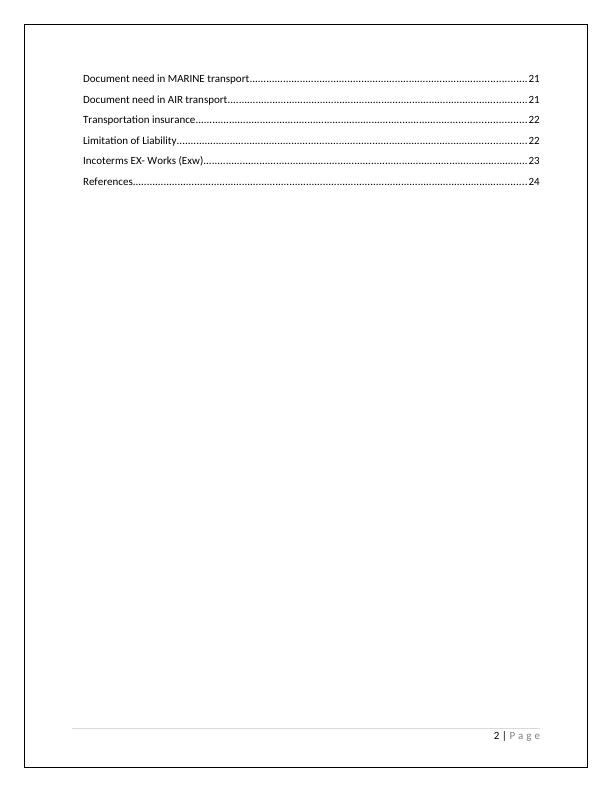
Task OneA commercial fisher has tasked you with transporting 907.185kg of Live Crabs from Batticaloa, Sri Lanka to Bilingsgate Market, London.- Explain step-by-step how you intend to do this.- Justify your decision to take each of the steps you propose.- Outline the risks the exporter will be taking.- Offer costings- Include relevant documents or explanations of these documents in an appendix.Details:• Commodity: Live Crabs (Fresh Lagoon Crabs)• Pickup point: Batticaloa, Sri Lanka• Shipper: Anura Fish Exporters (Pvt) Ltd. - Batticaloa, Sri Lanka• Consignee in UK: Fresh Fish Inc. Bilingsgate Market, London, UK• Incoterm: DDP - Fresh Fish Inc. Bilingsgate Market, London, UK (Delivered Duty Paid)• Cargo Gross weight: 907.185 Kg (including the weight of the cartons)• Cargo Dimensions: Master carton size 40" x 35" x 35" --- 60 Nos of Master Cartons• Payment Terms: Letter of credit (L/C)• Origin Airport: Colombo (CMB) - Sri Lanka *if by Air• Origin Sea Port: Colombo, Sri Lanka *if by Sea• Destination Airport: Heathrow (LHR) - United Kingdom *if by Air• Destination Sea Port: Felixtowe - UK *if by Sea3 | P a g e
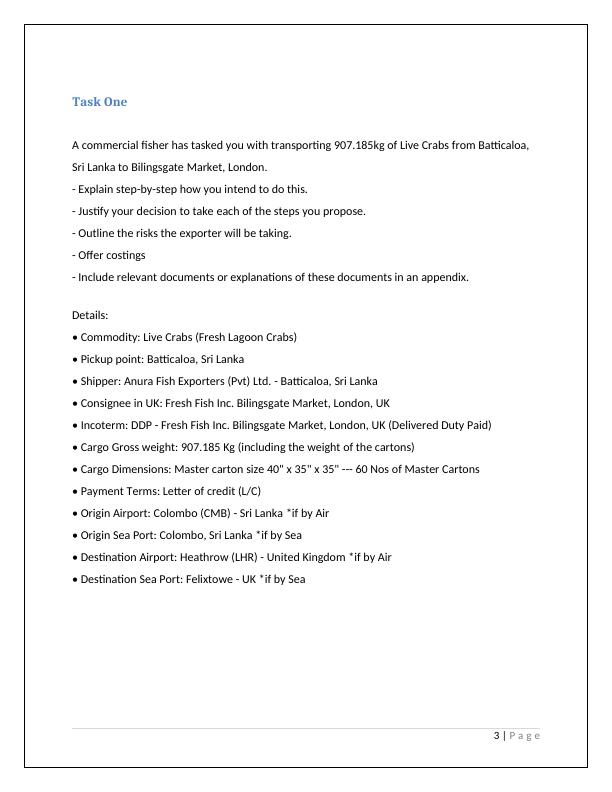
All Procedures and steps for an Export of live crabsKey information on the handling, sorting and storage of live crabs for harvesters before transport.Confirm legal size, sex and not berried as per state/territory regulations for export and inspection. Tie crab’s claws hard against the body to restrict movement as soon as possible. This minimizes crab stress, aggression and damage to other crabs and handlers. Apply care when legs are caught in basket. Pulling on legs can cause bleeding which increases likelihood of death. Remove weak, slow or bleeding crabs. These may be revived using a recovery procedure. Put 5 to 7 crabs in one eskies/boxes and fill it with ¼ of salt water.Storage of Live crabsTemperature variation is a principal cause of mortality in the live transport of crabs and the Importanceof maintaining low water temperatures at about 8 degree C cannot be stressed too highly. The mainbenefits are that at low temperatures crabs are less active. As such they produce less metabolic wastesand require less oxygen to breathe, so putting a reduced demand on the water in which they aretravelling.Avoid exposure to sunlight and breeze. Transport vehicle cargo area should be cooled at 18ºC to 25ºC. Packing crabs Cool crabs to 18-25°C if possible prior to packaging. Provide air holes in eskies/boxes (2 in winteror dry season, 4 in summer or wet season). If refrigerated transport is less than 15°C, reduce thenumber of air holes. Discard weak crabs - badly damaged, very slow or frothing crabs should be killed or removed because these crabs will not survive further transportation. Live crabs can be packed in layers separated by moistened material such as wood shavings, newspapers or burlap. A layer of moistened materials can be placed on top. The box should have ventilation holes on the top edge. Crabs should not be packed as high as the ventilation holes.4 | P a g e
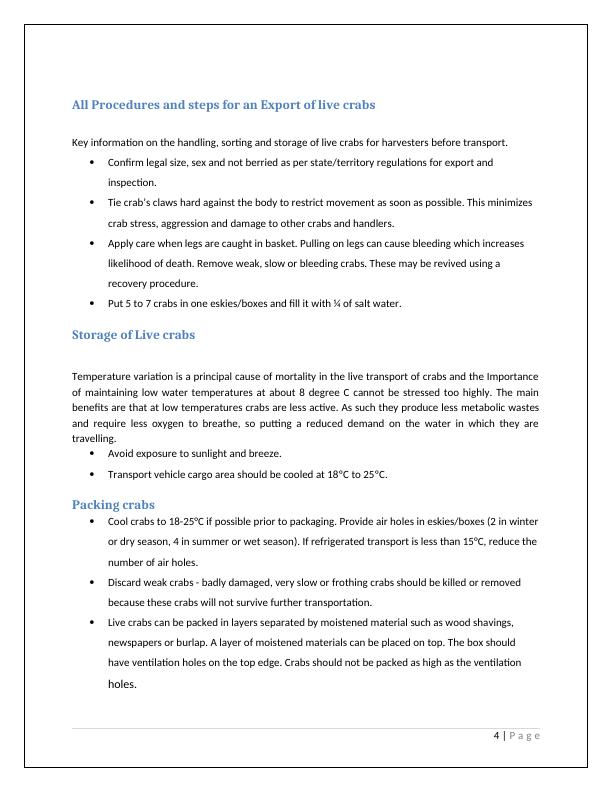
When packing the live crabs ;The first pair of largest legs with pincers(chelate legs) of each crab should be firmly tied up to the body by nylon thread to avoid damages .fight and movement of cannibalism among the crabs , while packing to the box place some wet seaweeds in between and add a small quantity of sea water (1/4 of the box)to the packed layers of crabs to enhance moist and cool condition during the transport for place to destination, the best method of transporting live tied-up crabs are washed with fresh sea water and packed on either in bamboo basket or in perforated Styrofoam boxes for export purpose.Mark and symbols eskies/boxes with: Live Product Fragile This Way Up Keep Cool but NOT Refrigerated Provide traceability of product – state of origin at least 5 | P a g e
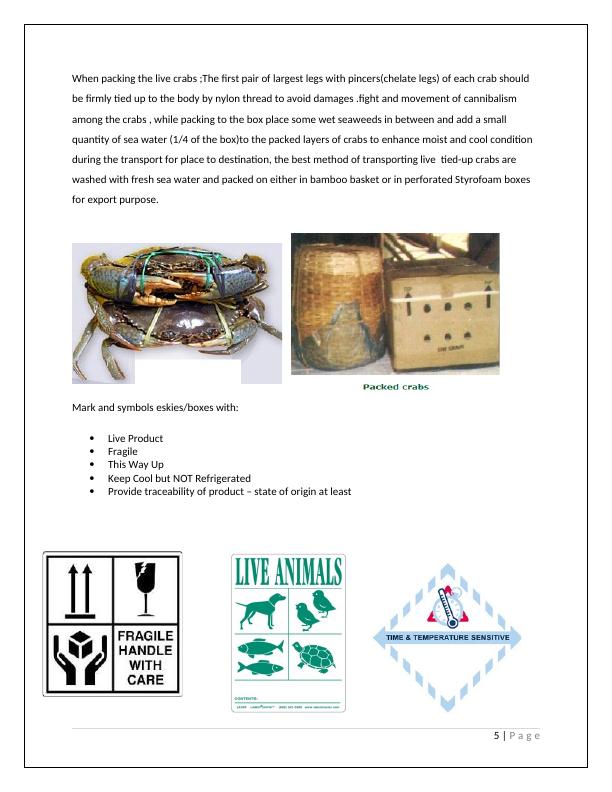
Why use air freightWhen we consider the shipment of live crabs it only stay alive for maximum of 4 to 5 days; so theshipment of live crabs cannot be done via sea freight because of the fact that even the fastest oceanservice from Colombo to port of Southampton is about 18 days. And also considering about live crabsthe standard containers are air tight and there will be no ventilation for the crabs. Since we are dealingwith live crabs sea freight is not an option. So considering these facts the only option to transport thelive crabs is by using air freight.Air cargo is often utilized for high value and low capacity shipments. The customary procedure of aircargo dispatch is to consign a consignment enclosed by an air waybill to a cargo air carrier. Airfreight is quicker and has higher security than ocean freight; therefore the premium rate usually islower. Worldwide airports can be reached in one day or during a few hours by airfreight, so reducing therisks of thievery and harm to the products. Delivery to bound areas might take many weeks to arrive byocean freight. Time sensitive products such as live Crab (According to scenario) perishables often rely onair cargo.When we take the above scenario of transporting live crabs from Colombo (CMB) - Sri Lanka to theConsignee in, London (LHR), United Kingdom. Sri Lankan Airlines (UL) prime services should be used,since it provides a direct transport to the Final destination London (LHR) and also because of the factthat we should deliver live crabs not dead ones, where other standard general cargo services use transit,and may be delay in shipping, which ultimately result in delivering dead crabs. The Srilankan airline provides extra special care to Perishables such as fish, meat, dairy, fruit andvegetables. Specially maintained temperatures and storage facilities handled by professionally trainedstaff ensure perishables come in peak condition. Documents and approval needed for exports crabs from Srilanka6 | P a g e
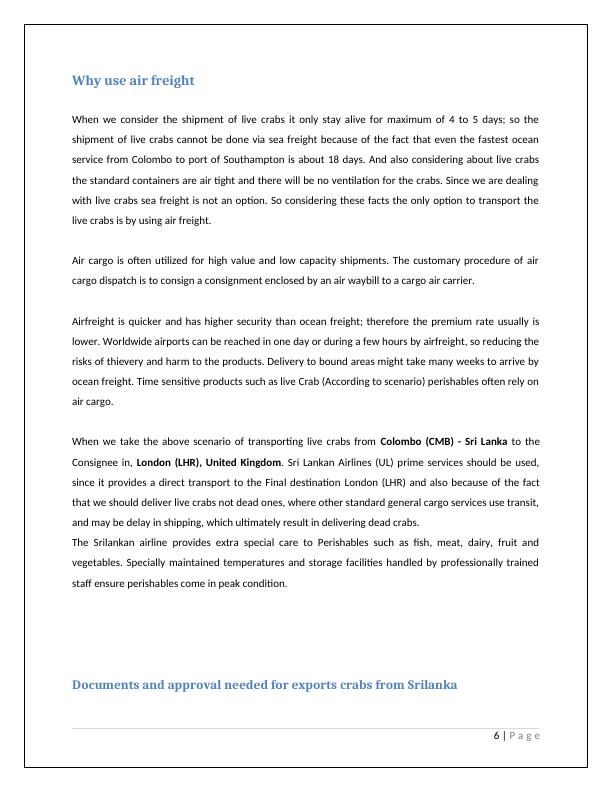
End of preview
Want to access all the pages? Upload your documents or become a member.
